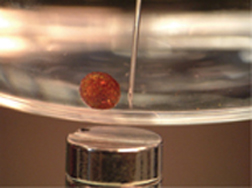- More than 2 years ago
While many chemists are working to reduce the elements of a chemistry lab to a single chip replete with miniature pumps, channels, and valves, others are striving for a simpler route to miniaturization. Rather than shuttling liquids through complex microfluidic plumbing, some scientists have imagined doing all their chemistry by rolling drops of liquid from one chip location to the next. Now, a group of chemists has devised a strategy to fulfill this vision using nothing more than a magnet and a bit of dust.

It’s not ordinary dust, but smart dust: microparticles of porous silicon that resemble miniature shards of glass. Developed by Michael Sailor of the University of California, San Diego (UCSD), the particles can be made to reflect different wavelengths of light according to the specific chemical or biological molecule to which they’re bound (SN: 6/7/03, p. 362: Available to subscribers at Danger Detection).
To move drops of liquid across a chip, Sailor and his colleagues modified the particles’ surfaces so that one side was water repelling, or hydrophobic, and the other was water attracting, or hydrophilic. They also infused the dust with iron oxide to make it magnetic.
When the researchers squirted a drop of water into a petri dish containing the dust and an oily solution, the particles coated the drop with their hydrophilic sides facing inward and their hydrophobic sides facing the surrounding oil. The drop then resembled a red disco ball. With a handheld magnet under the petri dish, the researchers moved the drop in all directions across the surface. On a chip, a magnet could direct a drop to different chip locations for various steps of a reaction, says Sailor.
“There’s a lot of interest in keeping the actual chips as simple as possible to keep costs down,” says Antonio Garcia of Arizona State University in Tempe. “If you don’t need lots of sophisticated components, then that’s attractive.”
Because the smart dust reflects different wavelengths of light when in contact with different molecules, the researchers can track multiple drops simultaneously. Reporting in the December Nature Materials, the UCSD group created two dust-coated drops, one containing silver nitrate and the other containing potassium iodide. Each drop reflected a different pattern of wavelengths of light.
When brought together with magnets, the drops fused, and their contents formed silver iodide. Using a spectrometer, the researchers detected both spectral patterns from the combined drop.
Richard Fair of Duke University in Durham, N.C., calls the UCSD experiment an interesting demonstration, but he says there are more-effective ways of moving around drops. For instance, his group uses a series of electrodes buried in a hydrophobic surface. Applying a voltage to the electrodes one at a time causes segments of the surface to sequentially become hydrophilic, drawing along the water drop.
Sailor has plans to further develop his smart-dust scheme. With a magnetic head—similar to the one in a hard disk drive—under a chip, he envisions shuttling many drops around at high speeds in a programmed fashion.






